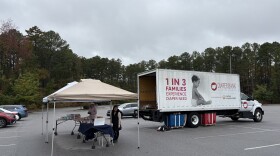Native Americans join the military at a high rate, but some struggle with the military's role in displacing and subjugating Indigenous people throughout the nation's history.
The National Mall in Washington, D.C. is generally quiet these days, as the resurgent COVID-19 pandemic keeps people home and the Smithsonian museums shuttered.
But those who do venture to its quiet paths will find something new - the National Native American Veterans Memorial on the grounds of the Museum of the American Indian. The memorial opened on Veterans Day with a virtual ceremony.
Former Colorado Senator Ben Nighthorse Campbell, a member of the Northern Cheyenne, was instrumental in the museum's creation; the bill to authorize it was among the first he passed in Congress.
"I join my Native brothers and sisters in our love for our country and our willingness to don the uniform of the United States to defend her when our nation needs us most," Campbell, a Korean War veteran, said in a video the museum produced to mark the new memorial's unveiling. "I take great pride in my service to our nation, and the service of our Native American people throughout the nation."
The heart of the leafy memorial is a tall silver ring. Water flows around its base, and the surrounding plaza is ringed by sculpted lances where people can attach prayer flags, as well as benches to sit and contemplate.

The memorial, titled "Warriors' Circle of Honor," was designed by the Cheyenne and Arapaho artist Harvey Pratt, a Vietnam Veteran who is also creating the Sand Creek memorial that will go on the grounds of the Colorado state capitol.
"Over and over, veterans said they wanted a place to heal. Remember yes, that's what a memorial is, but also a place for healing," said Alexandra Harris, a museum senior editor and writer.
Harris recently authored a book and an exhibition about Native veterans and their reasons for serving. It's widely repeated that Native Americans serve in the military at a higher rate than any other ethnic group. But according to Harris, that's actually a long-running bit of government propaganda. She traced it back to the World War I and the Commissioner of Indian Affairs, Cato Sells, who used the phrase in his efforts to get more Native Americans to enlist.
"He was a staunch assimilationist. He believed that American Indians should give up their culture and land. And he saw the war as an avenue to do so," said Harris.
That said, Native Americans do join the military at a high rate and have fought in every U.S. conflict going back to the Revolutionary War. However, given the military's role in the displacement and subjugation of Indigenous people throughout the course of the nation's history, the idea that many Native Americans see themselves as part of a tradition of military service may seem a bit contradictory to non-Natives.
"How do you square that tradition with what you understand about Native American history and the nation's relationship with Native people?" said Historian Mark Hirsch, Harris's coauthor. It's a question their book, Why We Serve, tries to answer.
Many of the reasons have a universal ring: Some Native American service members come from military families or were drafted, or they were looking for a new opportunity and a way out of a bad situation. For many, it's the opportunity to defend the homeland they've inhabited for millennia.
Jeffrey Means signed up with the Marines as a young man because he lacked other opportunities after high school. He's a member of the Oglala Sioux nation and found the Marine Corps was welcoming, if less than politically correct.
"I had a fellow Marine who looked a whole lot more Native American than I do, and of course his nickname was Chief," Means recalled.
Means is now a history professor at the University of Wyoming. He speaks fondly of his time in the Marines, but doesn't downplay the military's role in displacing Native tribes throughout the nation's history.
"The United States military has done many wonderful and honorable things," he said. "We don't need to pretend that the United States Army never did anything bad. it's just, it's just not factual."
Means notes that even during Westward Expansion, the military's relationship with Native tribes was often contradictory. U.S. troops committed numerous massacres and atrocities. But individual soldiers were often more familiar with Native Americans than civilian settlers were.
"So they were generally treated better by U.S. soldiers and more reasonably, because they didn't have that mass hysteria of, 'Oh my gosh, the savage is going to come kill us.'"
The military's infamous legacy with tribes continues to linger. The 1890 massacre at Wounded Knee resulted in 20 Medals of Honor, and Congressional efforts to rescind them have so far stalled. The CIA's codename for Osama Bin Laden was "Geronimo," after the Apache chief. Today, some military commanders continue to refer to hostile territory overseas as "Indian Country."
The campaign website for President-Elect Joe Biden addresses those issues, declaring that his administration will "demonstrate respect for Native communities by changing military naming conventions that label enemy-held territory as 'Indian Country' and codenames enemy combatants after historic indigenous and tribal figures."
"I think America as a country hasn't really grappled with its history with Native people," said the Smithsonian's Harris. "So, from the top down, we can't infuse our institutions in this country with that level of reconciliation that we need to do with Native people until the nation can address that history and see them as individuals and not stereotypes."
This story was produced by the American Homefront Project, a public media collaboration that reports on American military life and veterans. Funding comes from the Corporation for Public Broadcasting.
9(MDAxNzg0MDExMDEyMTYyMjc1MDE3NGVmMw004))
Copyright 2020 North Carolina Public Radio – WUNC








